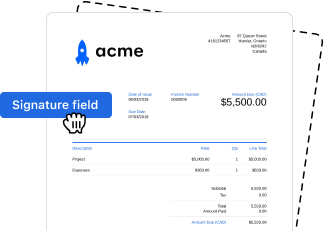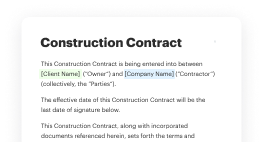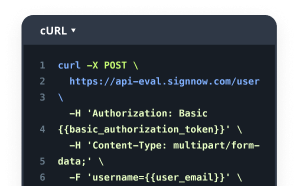eSignature Legitimacy for Pharmaceutical in European Union
- Quick to start
- Easy-to-use
- 24/7 support
Simplified document journeys for small teams and individuals




We spread the word about digital transformation
Why choose airSlate SignNow
-
Free 7-day trial. Choose the plan you need and try it risk-free.
-
Honest pricing for full-featured plans. airSlate SignNow offers subscription plans with no overages or hidden fees at renewal.
-
Enterprise-grade security. airSlate SignNow helps you comply with global security standards.







Your complete how-to guide - e signature legitimacy for pharmaceutical in european union
eSignature Legitimacy for Pharmaceutical in European Union
In the Pharmaceutical industry, ensuring the legitimacy of electronic signatures is crucial, especially with the strict regulations in the European Union. One solution to streamline this process is airSlate SignNow, a reliable eSignature platform.
How to Use airSlate SignNow for eSignatures:
- Launch the airSlate SignNow web page in your browser.
- Sign up for a free trial or log in.
- Upload a document you want to sign or send for signing.
- If you're going to reuse your document later, turn it into a template.
- Open your file and make edits: add fillable fields or insert information.
- Sign your document and add signature fields for the recipients.
- Click Continue to set up and send an eSignature invite.
airSlate SignNow empowers businesses to send and eSign documents with an easy-to-use, cost-effective solution. It offers a great ROI with a rich feature set, is easy to use and scale for SMBs and mid-market companies, provides transparent pricing without hidden fees, and delivers superior 24/7 support for all paid plans.
Experience the benefits of airSlate SignNow today and streamline your eSignature processes effortlessly!
How it works
Rate your experience
What is the e signature legitimacy for pharmaceutical in european union
The e signature legitimacy for pharmaceutical in the European Union refers to the legal recognition and acceptance of electronic signatures in the pharmaceutical sector. This legitimacy is established under the eIDAS Regulation, which outlines the conditions under which electronic signatures are considered valid. The regulation ensures that eSignatures have the same legal standing as handwritten signatures, provided they meet specific criteria. This is particularly important for pharmaceutical companies that need to comply with strict regulatory requirements while ensuring efficient document management and workflow processes.
How to use the e signature legitimacy for pharmaceutical in european union
To utilize the e signature legitimacy for pharmaceuticals in the European Union, organizations should follow a structured approach. First, ensure that the electronic signature solution complies with eIDAS requirements. Next, identify the documents that require signatures, such as contracts, regulatory submissions, or internal approvals. Users can then fill out these documents electronically using airSlate SignNow, integrating fields for signatures, dates, and other necessary information. Once completed, the documents can be sent for signature to relevant parties, who can eSign from any location. This process streamlines workflows while maintaining compliance with legal standards.
Steps to complete the e signature legitimacy for pharmaceutical in european union
Completing the e signature legitimacy process for pharmaceuticals involves several key steps:
- Choose a compliant eSignature solution, such as airSlate SignNow, that adheres to eIDAS regulations.
- Prepare the document that needs to be signed, ensuring all necessary fields are included.
- Fill out the document electronically, adding any required information or attachments.
- Send the document for signature to the relevant parties, specifying the order of signing if needed.
- Monitor the signing process through the eSignature platform, which provides real-time updates.
- Once all parties have signed, securely store the completed document for future reference.
Legal use of the e signature legitimacy for pharmaceutical in european union
The legal use of e signatures in the pharmaceutical sector within the European Union is governed by the eIDAS Regulation, which establishes the criteria for valid electronic signatures. To be legally binding, an eSignature must be created using a secure method that ensures the signer's identity and intent. This includes advanced electronic signatures (AdES) that utilize digital certificates. Pharmaceutical companies must ensure that their eSignature practices comply with these regulations to avoid legal disputes and ensure regulatory compliance.
Security & Compliance Guidelines
When implementing e signatures in the pharmaceutical sector, security and compliance are paramount. Organizations should follow these guidelines:
- Use a reputable eSignature platform that complies with eIDAS and other relevant regulations.
- Implement strong authentication methods to verify the identity of signers.
- Ensure that all documents are encrypted during transmission and storage to protect sensitive information.
- Maintain an audit trail of all signing activities, including timestamps and IP addresses, to provide proof of compliance.
- Regularly review and update security protocols to address emerging threats and vulnerabilities.
Documents You Can Sign
In the pharmaceutical industry, a variety of documents can be signed electronically. These include:
- Contracts with suppliers and vendors
- Regulatory submissions to health authorities
- Internal approvals for research and development projects
- Clinical trial agreements
- Employee onboarding and HR documents
Utilizing e signatures for these documents enhances efficiency and ensures compliance with legal standards.
-
Best ROI. Our customers achieve an average 7x ROI within the first six months.
-
Scales with your use cases. From SMBs to mid-market, airSlate SignNow delivers results for businesses of all sizes.
-
Intuitive UI and API. Sign and send documents from your apps in minutes.
FAQs
-
What is the e signature legitimacy for pharmaceutical in European Union?
The e signature legitimacy for pharmaceutical in European Union refers to the legal acceptance of electronic signatures in the pharmaceutical sector, ensuring compliance with EU regulations. This legitimacy allows pharmaceutical companies to streamline their document processes while maintaining regulatory standards. By using airSlate SignNow, businesses can confidently adopt e-signatures that are recognized across the EU.
-
How does airSlate SignNow ensure compliance with e signature legitimacy for pharmaceutical in European Union?
airSlate SignNow adheres to the eIDAS regulation, which governs electronic signatures in the EU, ensuring that all e-signatures are legally binding. Our platform provides features such as audit trails and secure storage, which are essential for compliance in the pharmaceutical industry. This commitment to compliance reinforces the e signature legitimacy for pharmaceutical in European Union.
-
What are the benefits of using airSlate SignNow for e signatures in the pharmaceutical industry?
Using airSlate SignNow for e signatures in the pharmaceutical industry offers numerous benefits, including increased efficiency, reduced turnaround times, and enhanced security. The platform's user-friendly interface allows for quick adoption, while its compliance features ensure e signature legitimacy for pharmaceutical in European Union. This leads to improved workflow and productivity for pharmaceutical companies.
-
Are there any integration options available with airSlate SignNow for pharmaceutical companies?
Yes, airSlate SignNow offers a variety of integration options with popular software used in the pharmaceutical industry, such as CRM and document management systems. These integrations facilitate seamless workflows and enhance the overall efficiency of document handling. By ensuring e signature legitimacy for pharmaceutical in European Union, these integrations help maintain compliance while streamlining processes.
-
What pricing plans does airSlate SignNow offer for pharmaceutical companies?
airSlate SignNow provides flexible pricing plans tailored to meet the needs of pharmaceutical companies, ensuring cost-effectiveness while maintaining compliance. Our plans include features that support e signature legitimacy for pharmaceutical in European Union, allowing businesses to choose the best option for their requirements. Contact our sales team for detailed pricing information and to find the right plan for your organization.
-
How secure is the e signature process with airSlate SignNow?
The e signature process with airSlate SignNow is highly secure, utilizing advanced encryption and authentication methods to protect sensitive information. Our platform ensures that all e signatures are compliant with the e signature legitimacy for pharmaceutical in European Union, providing peace of mind for businesses in the industry. Regular security audits further enhance the trustworthiness of our solution.
-
Can airSlate SignNow help with document tracking and management for pharmaceutical companies?
Absolutely! airSlate SignNow includes robust document tracking and management features that allow pharmaceutical companies to monitor the status of their e signed documents in real-time. This capability supports the e signature legitimacy for pharmaceutical in European Union by providing a clear audit trail and ensuring compliance with regulatory requirements. Efficient document management leads to better organization and accountability.
Related searches to e signature legitimacy for pharmaceutical in european union
Join over 28 million airSlate SignNow users
Get more for e signature legitimacy for pharmaceutical in european union
- Streamline Your Business with our Digital Signature ...
- Revamp Your Office 365 Signature Block Effortlessly
- Simplify Document Workflow with the Ultimate Fill and ...
- How to Edit PDF Signed Document Easily with airSlate ...
- Discover How to Change Signature on Docusign Document ...
- Sign a PDF with a Digital Signature for Seamless ...
- Unlock the Secret to Setting Your Email Signature in ...
- Empower Your Business with airSlate SignNow's Docusign ...




























